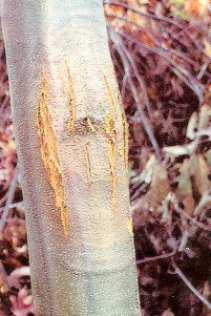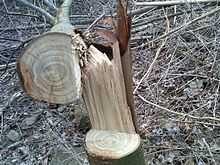Chestnut blight
| Chestnut blight fungus | |
|---|---|
 | |
| Cankers caused by the fungal infection cause the bark to split. | |
| Scientific classification | |
| Kingdom: | Fungi |
| Phylum: | Ascomycota |
| Subphylum: | Pezizomycotina |
| Class: | Sordariomycetes |
| Order: | Diaporthales |
| Family: | Cryphonectriaceae |
| Genus: | Cryphonectria |
| Species: | C. parasitica |
| Binomial name | |
| Cryphonectria parasitica (Murrill) Barr | |
The pathogenic fungus Cryphonectria parasitica (formerly Endothia parasitica) is a member of the Ascomycota (sac fungi) taxon, and is the main cause of chestnut blight—a devastating disease of the American chestnut tree that in the early 1900s caused a rapid, widespread die-off of this once plentiful tree from its historic range in the eastern United States.
Overview
The chestnut blight was accidentally introduced to North America around 1900, possibly on imported Japanese chestnut nursery stock. In 1905, American mycologist William Murrill isolated and described the fungus responsible (which he named Diaporthe parasitica), and demonstrated by inoculation into healthy plants that the fungus caused the disease.[1] By 1940, most mature American chestnut trees had been wiped out by the disease.[2]
Infection of American chestnut trees with C. parasitica simultaneously appeared in numerous places on the east coast, most likely from Castanea crenata, or Japanese chestnut, which had become popular imports.[3] Japanese and some Chinese chestnut trees have some resistance to infection by C. parasitica: the infection usually does not kill these Asian chestnut species. Within 40 years the nearly four-billion-strong American chestnut population in North America was devastated[4] — only a few clumps of trees remained in California, Michigan, Wisconsin and the Pacific Northwest. Because of the disease, American chestnut wood almost disappeared from the market for decades, although it can still be obtained as reclaimed lumber.[5]
It is estimated that in some places, such as the Appalachian Mountains, one in every four hardwoods was an American chestnut. Mature trees often grew straight and branch-free for 50 feet and could grow up to 100 feet tall with a trunk diameter of 14 feet at a few feet above ground level. For three centuries many barns and homes near the Appalachian Mountains were made from American chestnut.[6]
The root collar and root system of the chestnut tree have some resistance against the fungal infection; consequently, a large number of small American chestnut trees still exist as shoots growing from existing root bases. However, these regrown shoots seldom reach the sexually reproductive stage before being killed by the fungus.[7] They only survive as living stumps, or "stools," with only a few growing enough shoots to produce seeds. This is just enough to preserve the genetic material necessary to engineer an American chestnut tree using genes from any of the disease-immune Asiatic species to confer resistance to the disease. Efforts started in the 1930s and are still ongoing, in Massachusetts[8] and many other places in the United States, to repopulate the country with these trees.[4]
The American chinquapin is also highly susceptible to chestnut blight. The European chestnut and the West Asian species are also susceptible, but less so than the American species. Surviving chestnut trees are being bred for resistance to the blight, notably by the American Chestnut Foundation, which aims to reintroduce a blight-resistant American chestnut to its original forest range within the early decades of the 21st century.[9] The resistant species—particularly Japanese chestnut and Chinese chestnut, as well as Seguin's chestnut and Henry's chestnut—have been used in these breeding programs in the US to create disease-resistant hybrids with the American chestnut.[10]
The fungus is spread by wind-borne ascospores and, over a shorter distance, conidia distributed by rain-splash action. Infection is local in range, so some isolated American chestnuts survive where there is no other tree within 10 km. Also, there are at least two viral pathogens that weaken the fungus through a mechanism, termed hypovirulence that helps trees to survive.[11][12]
A small stand of surviving American chestnuts was found in F. D. Roosevelt State Park near Warm Springs, Georgia on April 22, 2006, by Nathan Klaus of the Georgia Department of Natural Resources.[13][14]
Symptoms

The fungus enters through wounds and grows in and beneath the bark, eventually killing the cambium all the way round the twig, branch or trunk.[15] The first symptom of C. parasitica infection is a small orange-brown area on the tree bark. A sunken canker then forms as the mycelial fan spreads under the bark. As the hyphae spread, they produce several toxic compounds, the most notable of which is oxalic acid. This acid lowers the pH of the infected tissue from around the normal 5.5 to approximately 2.8, which is toxic to plant cells. The canker eventually girdles the tree, killing everything above it. Distinctive yellow tendrils (cirrhi) of conidia can be seen extruding in wet weather.[16]
Conservation efforts
There are approximately 2,500 chestnut trees growing on 60 acres near West Salem, Wisconsin, which is the world's largest remaining stand of American chestnut. These trees are the descendants of those planted by Martin Hicks, an early settler in the area. In the late 1800s, Hicks planted less than a dozen chestnuts. Planted outside the natural range of chestnut, these trees escaped the initial wave of infection by chestnut blight, but in 1987, scientists found blight also in this stand. Scientists are working to try to save the trees. There is a program to bring American chestnut back to the Eastern forest and funded by the American Chestnut Foundation, Wisconsin Department of Natural Resources, USDA Forest Service, West Virginia University, Michigan State University, and Cornell University.[17]
Removing blighted trees to control the disease was first attempted when the blight was discovered, but this proved to be an ineffective solution. Scientists then set out to introduce a hypovirus into the chestnut blight fungus. The trees infected with virus-treated fungus responded immediately and began to heal over their cankers. However, the virus was so efficient at attenuating fungal growth that it prevented spreading of the virus from an infected fungus growing on one tree to that growing on another tree. Only the virus-treated trees recovered. Scientific opinion regarding the future of the stand varies.[17]
Hybrid chestnut trees
In the years since the chestnut blight, many scientists and botanists have worked to create a resistant hybrid chestnut tree that retains the main characteristics of the American chestnut tree. In the early 1950s, James Carpenter discovered a large living American chestnut in a grove of dead and dying trees in Salem, Ohio that showed no evidence of blight infection. Carpenter sent budwood to Dr. Robert T. Dunstan, a plant breeder in Greensboro, North Carolina. Dunstan grafted the scions onto chestnut rootstock and the trees grew well. He cross-pollinated one with a mixture of 3 Chinese chestnut selections: "Kuling," "Meiling," and "Nanking." The resulting fruit-producing hybrid was named the Dunstan chestnut.[18] The trade off for resistance to the chestnut blight is that the Dunstan hybrid grew to a height of only twenty-five feet or 7.6 meters.
Current efforts are under way by the Forest Health Initiative to use modern breeding techniques and genetic engineering to create resistant tree strains, with contributions from SUNY College of Environmental Science and Forestry, Penn State, the University of Georgia, and the US Forest Service. One of the most successful methods of breeding is to create a back cross of a resistant species (such as one from China or Japan) and American chestnut. The two species are first bred to create a 50/50 hybrid. After three back crosses with American chestnut, the remaining genome is approximate 1/16 that of the resistant tree, and 15/16 American. The strategy is to select blight-resistance genes during the back crossing, while preserving the more wild-type traits of American chestnut as the dominant phenotype. Thus, the newly bred hybrid chestnut trees should reach the same heights as the original American chestnut. Research is also being conducted at the State University of New York College of Environmental Science and Forestry, by using the bacterial vector, Agrobacterium tumefaciens, to insert resistance genes from wheat {cupin superfamily} into American chestnut. The inserted genes are present only in the resistant strain, and not in the native American chestnut, and are tested for their potential to produce blight-resistant trees. In 2013, SUNY ESF had over 100 individual events being tested, with more than 400 slated to be in the field or in the lab for various assay tests in the next several years[19] and more than 1,000 trees growing in several field sites in 2014.[20]
Popular culture
- In his book My Life and Hard Times, cartoonist James Thurber's grandfather claims that his uncle "Zenas died of chestnut blight!"[21]
- In the series Malcolm in the Middle during the episode Reese's Job, Barton says: "Wow An entire colony of Cryphonectria parasitica"[22]
- In the book Prodigal Summer by Barbara Kingsolver, one of the characters, an old man called Garnett, dreams of restoring the American chestnut to the landscape.[23]
The humor travelogue writer Bill Bryson wrote of the history of the chestnut and its importance to 17th through 19th century culture in his book, A Walk in the Woods (Doubleday 1998)
See also
References
- ↑ Rogerson CT, Samuels GJ. (1996). Mycology at the New York Botanical Garden, 1985-1995. Brittonia 48(3):389-98
- ↑ American Chestnut: The Life, Death, and Rebirth of a Perfect Tree, Susan Freinkel, p 81
- ↑ American Chestnut: The Life, Death, and Rebirth of a Perfect Tree, Susan Freinkel, p 68
- ↑ 4.0 4.1 The American Chestnut Foundation - Mission & History.
- ↑ Trees, Woods and Man. By H.L. Edlin. New Naturalist. 1970. ISBN 0-00-213230-3.
- ↑ American Chestnut Restoration. Salem Board & Beam.
- ↑ History of the American Chestnut
- ↑ The American Chestnut Returns. By Fred Thys, for WBUR news. July 18, 2008.
- ↑ http://www.fs.fed.us/r8/chestnut/qa.php
- ↑ New RHS Dictionary of Gardening. By A. Huxley ed. 1992. Macmillan ISBN 0-333-47494-5.
- ↑ Milgroom MG, Cortesi P. (2004). "Biological control of chestnut blight with hypovirulence: a critical analysis". Annual Review of Phytopathology 42: 311–38. doi:10.1146/annurev.phyto.42.040803.140325. PMID 1528366.
- ↑ Hypovirulence-Infecting the infection
- ↑ Rare American Chestnut Trees Discovered (Washington Post 2006-05-19)
- ↑ http://www.msnbc.msn.com/id/12861536/ns/technology_and_science-science/
- ↑ Anagnostakis SL (2000) Revitalization of the Majestic Chestnut: Chestnut Blight Disease.
- ↑ Crop Protection Compendium 2005 Edition. Cryphonectria parasitica (blight of chestnut). CAB International, Wallingford, UK.
- ↑ 17.0 17.1 Chestnut's Last Stand
- ↑ http://www.chestnuthilltreefarm.com/Dunstan-Chestnut-Trees-1918.Category.html
- ↑ Wines, Michael (July 13, 2013). "Like-Minded Rivals Race to Bring Back an American Icon". New York Times. Retrieved July 14, 2013.
- ↑ Powell, William (march 2014) "the American Chestnut's Genetic Rebirth", Scientific American, Volume 310, Number 3, Page 52
- ↑ My Life and Hard Times
- ↑ http://en.wikiquote.org/wiki/Malcolm_in_the_Middle#.22Reese.27s_Job.22_.5B3.9.5D
- ↑ http://www.h-net.org/reviews/showrev.php?id=4944
Roane, M. K., Griffin, G .J. & Elkins, J. K. 1986. Chestnut Blight, Other Endothia Diseases, and the Genus Endothia. American Phytopathological Society, APS Press, St. Paul.